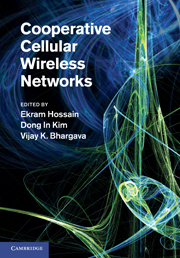Book contents
- Frontmatter
- Contents
- List of contributors
- Preface
- Part I Introduction
- Part II Cooperative base station techniques
- Part III Relay-based cooperative cellular wireless networks
- 6 Distributed space-time block codes
- 7 Collaborative relaying in downlink cellular systems
- 8 Radio resource optimization in cooperative cellular wireless networks
- 9 Adaptive resource allocation in cooperative cellular networks
- 10 Cross-layer scheduling design for cooperative wireless two-way relay networks
- 11 Green communications in cellular networks with fixed relay nodes
- 12 Network coding in relay-based networks
- Part IV Game theoretic models for cooperative cellular wireless networks
- Part V Standardization activities
- Index
10 - Cross-layer scheduling design for cooperative wireless two-way relay networks
from Part III - Relay-based cooperative cellular wireless networks
Published online by Cambridge University Press: 03 May 2011
- Frontmatter
- Contents
- List of contributors
- Preface
- Part I Introduction
- Part II Cooperative base station techniques
- Part III Relay-based cooperative cellular wireless networks
- 6 Distributed space-time block codes
- 7 Collaborative relaying in downlink cellular systems
- 8 Radio resource optimization in cooperative cellular wireless networks
- 9 Adaptive resource allocation in cooperative cellular networks
- 10 Cross-layer scheduling design for cooperative wireless two-way relay networks
- 11 Green communications in cellular networks with fixed relay nodes
- 12 Network coding in relay-based networks
- Part IV Game theoretic models for cooperative cellular wireless networks
- Part V Standardization activities
- Index
Summary
Introduction
Background. The degrees of freedom introduced by multiple antennas at the transmitters and receivers of wireless communication systems facilitate multiplexing gains and diversity gains. A wireless point-to-point link with M transmit and N receive antennas constitutes an M-by-N multiple-input multiple-output (MIMO) communication system. The ergodic capacity of an M-by-N MIMO fading channel increases almost linearly with min{M,N} provided that the fading meets certain mild conditions. Hence, it is not surprising that MIMO has attracted a lot of research interest since it enables significant performance and throughput gains without requiring extra transmit power and bandwidth. However, limitations on the number of antennas that a wireless device is able to support as well as the significant signal processing power and complexity required in MIMO tranceivers limit the gains that can be achieved in practice.
To overcome the limitations of traditional MIMO, the concept of cooperative communication has been proposed for wireless networks such as fixed infrastructure cellular networks and wireless ad-hoc networks. The basic idea of cooperative communication is that the single-antenna terminals of a multiuser system can share their antennas and create a virtual MIMO communication system. Thereby, three different types of cooperation may be distinguished, namely, user cooperation, base station (BS) cooperation, and relaying. Theoretically, user cooperation and BS cooperation are able to provide huge performance gains, when compared with noncooperative networks. However, the required information exchange between users and BSs may make these options less attractive in practice.
- Type
- Chapter
- Information
- Cooperative Cellular Wireless Networks , pp. 259 - 299Publisher: Cambridge University PressPrint publication year: 2011



